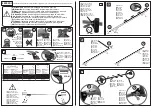
Section 8 – Inspection, Service & Maintenance
R4 3/30/2017
Page 45
out until the pressure of the linings against the
drum makes the wheel very difficult to turn.
•
Note: Your trailer maybe equipped with drop
spindle axles. See axle manual for your axle
type. You will need a modified adjusting tool
for adjusting the brakes in these axles. With
drop spindle axles, a modified adjusting tool
with about an 80 degree angle should be used.
•
Rotate the starwheel in the opposite direction
until the wheel turns freely with a slight drag.
•
Replace the adjusting-hole cover.
•
Repeat the above procedure on all brakes.
•
Lower the trailer to the ground.
8.2.5.d Brakes, Hydraulic (Air or Electric
Operated)
If your trailer has hydraulically-operated brakes,
they function the same way the hydraulic brakes do
on your tow vehicle. The hydraulic braking system
must be inspected by a dealer, at least as often as
the brakes on the tow vehicle, but no less than once
per year. This inspection includes an assessment of
the condition and proper operation of the wheel
cylinders, brake shoes, brake drums and hubs.
You must check the fluid level in the master
cylinder reservoir at least every three months. If
you tow your trailer an average of 1,000 miles per
month in a hot and dry environment, you must
check the brake fluid level once a month. The
brake fluid reservoir is located on the tongue of the
trailer. Fill with DOT 4 brake fluid.
Air Pressure-Operated Hydraulic
Air/hydraulic braking systems are typically used
when the tow vehicle has a diesel engine. The tow
vehicle has an air compressor that routes the air to
an air/hydraulic mechanism, which sends brake
fluid to the wheel cylinders.
The air pressure gauge in your tow vehicle indicates
the current air pressure. See your tow vehicle
manual for the proper air pressure.
Electrical-Operated Hydraulic
Electric/hydraulic braking systems, which are
mounted on the trailer, use a small electrically-
driven pump to generate hydraulic pressure, which
operates the brake cylinders. Like electrical brakes,
an electric/hydraulic braking system is operated by
an electrical signal from the tow vehicle.
8.2.6 Trailer Connection to Tow Vehicle
8.2.6.a Coupler and Ball
The coupler on the trailer connects to the ball
attached to the hitch on the tow vehicle. The
coupler, ball and hitch transfer the towing forces
between the tow vehicle and the trailer. Before
each tow, coat the ball with a thin layer of
automotive bearing grease to reduce wear and
ensure proper operation; and check the locking
device that secures the coupler to the ball for proper
operation.
If you see or feel evidence of wear, such as flat
spots, deformations, pitting or corrosion, on the ball
or coupler, immediately have your dealer inspect
them to determine the proper action to prevent
possible failure of the ball and coupler system. All
bent or broken coupler parts must be replaced
before towing the trailer.
The coupler handle lever must be able to rotate
freely and automatically snap into the latched
position. Oil the pivot points, sliding surfaces, and
spring ends with SAE 30W motor oil. Keep the
ball pocket and latch mechanism clean. Dirt or
contamination can prevent proper operation of the
latching mechanism.
When replacing a ball, the load rating must match
or exceed the GVWR of the trailer.
8.2.6.b Ring and Pintle
The ring on the trailer connects to the pintle
attached to the hitch on the tow vehicle. The ring,
pintle and hitch transfer the towing forces between
the tow vehicle and the trailer. Before each tow,
coat the ring with a thin layer of automotive bearing
grease to reduce wear and ensure proper operation;
and check the locking device that secures the pintle
to the ring for proper operation.
If you see or feel evidence of wear, such as flat
spots, deformations, pitting or corrosion, on the ring
or pintle, immediately have your dealer inspect
them to determine the proper action to prevent
possible failure of the ring and pintle system. All
bent or broken coupler parts must be replaced
before towing the trailer.
Summary of Contents for COACH TRAILERS
Page 1: ...COACH TRAILERS OWNER S MANUAL...
Page 6: ......










































